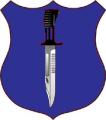I have real issues with blank ammunition on field exercises. Blanks, without TESEX kit, or very good umpiring and role players, provide negative reinforcement, - or bad training, - but there doesn't seem to be any other way to get around it. This one really keeps me thinking.






 In The RCR, we got around that by loading "Militia Bullets"
In The RCR, we got around that by loading "Militia Bullets" (shouting "Bang! Bang!" - pathetic isn't it?) when our regular ammo ran out.
(shouting "Bang! Bang!" - pathetic isn't it?) when our regular ammo ran out.





 ).
).



Bookmarks